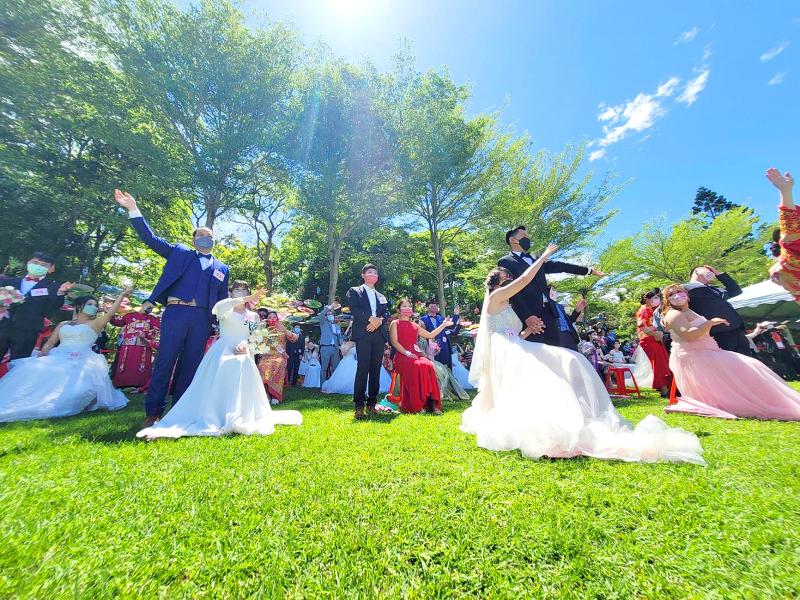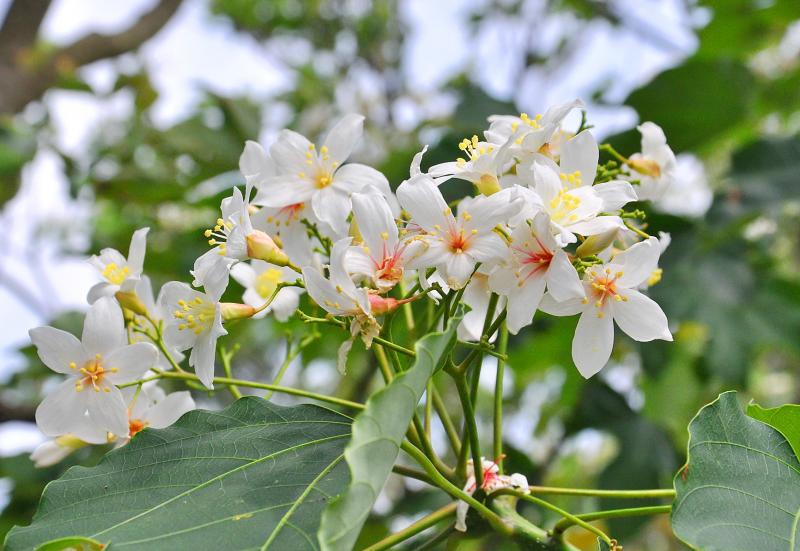Every nation has one, that wonderful place that doesn’t appear to show up much on tourist itineraries, except for a few well known tourist spots. Growing up in Michigan in the 70s, it was the state’s Upper Peninsula, one of America’s best-kept secrets. In Taiwan, that seems to be Miaoli County.
The government markets Miaoli’s Hakka culture, and there are a few odd places, such as the Longteng Viaduct, wrecked in an earthquake, and the nearby Shengsing (勝興) Train Station, which are tourist meccas. Indeed, the old train station, the highest on the main north-south line until the bypass was completed in 1998, is now a potent tourist trap filled with vendors hawking the same authentic souvenirs and local foods as every other old street on the island.
HILLS OF MIAOLI

Photo courtesy of Chang Ching-wen
The real treasure of the county is its hills. East of Sanyi, now the center of Taiwan’s woodworking industry and one of a string of old logging towns that dot the foothills of the central mountain range.
Miaoli abounds with hidden history. Near Tongsiao (通霄), off Highway 121, is the island’s tiny oil and gas field. On a hill above the town is the site where the Russian fleet was sighted by Japanese lookouts on its way to annihilation at the hands of Admiral Togo Heihachiro at Tsushima in May 1905. A much-defaced memorial still stands there, placed by the Japanese. At its foot sits a lovely restored Shinto temple.
Further north outside of Jhunan Township (竹南) is the little-known battlefield of Jianbi Mountain (尖筆山), where Hakka militia skirmished with Japanese troops in 1895. In central Miaoli, above the strawberry fields of Dahu (大湖), is another battlefield: Manabang Mountain (馬那邦山), where the Atayal people clashed with outsiders.

Photo: Peng Chien-li, Taipei Times
Follow the Daan River east (on the south side, the Daan Industry Road) into the hills past Siangbi (象鼻) and up through Tiangou (天狗). Above Tiangou the Japanese installed mountain guns and bombarded the local indigenous people. The views on the roads through there are astonishingly lovely, when they aren’t blocked by landslides.
From Shitan (獅潭), take Highway 124 for stunning ocean and mountain views, then fall to Nanjhuang, a well known tourist spot. Or turn west and run past the Mingde Reservoir toward Miaoli city. Take the tiny road, the Miaoli 16, on the south side, it’s much prettier.
I’ve spent many an hour biking Miaoli’s numerous small hill roads, steep and gorgeous, and wondering why the county is not better appreciated.

Photo: Chang Hsun-teng, Taipei Times
WHAT’S WRONG WITH MIAOLI? CORRUPTION
And also wondering: what is the matter with Miaoli? People talk about the declining populations of Pingtung and Taitung, yet Miaoli is no different. Depending on which count you accept, it has slightly fewer people now than it did in 1981. Miaoli’s best-kept secret may not be its incredible tourism potential, but its moribund economy and stagnating population. Miaoli is the Pingtung of the north.
For decades, with the exception of a couple of independent politicians, Miaoli has been a Chinese National Party (KMT) fiefdom. The KMT’s game of ethnic divide-and-rule was played to great advantage in Miaoli, where Hakkas constitute a large chunk of the population.
The results of one-party control are obvious. What industry is associated with Miaoli? I can’t think of one, either. Development has been established on either flank, in Hsinchu and Taichung, but Miaoli is flyover country. Development has passed it by.
One party rule means, inevitably, corruption, as it does all over Taiwan. In 2010 Miaoli KMT politician Ho Chih-hui (何智輝), once the county magistrate, became the subject of a massive corruption probe in relation to (what else?) a land case. To avoid a guilty verdict, he paid off a couple of High Court judges.
Anyone remember when the historic kilns, nearly the last in the county, were destroyed to make way for the Miaoli HSR station? The house of Liu Cheng-hung (劉政鴻), then the county magistrate, in the same area, remained untouched, protected by some interesting and lucrative land deals involving his son.
On the site of the demolished historic kilns, which represented local culture, the county government funded the construction of a Hakka roundhouse, a Chinese cultural item native to Fujian, not Taiwan. After its construction was announced, the Taiwan Hakka Think Tank (台灣客家智庫) organized a press conference to demand that Liu “immediately stop the building of a Chinese Hakka tulou [roundhouse] that has no connection with Taiwan.”
The county government also went into debt to fund other tourist sites.
‘THE COUNTY THAT DEBT BUILT’
The Taipei Times reported in 2015 in an article entitled “Miaoli: the county that debt built.”
“Liu’s tourist site building extravaganza likely had an ulterior motive: land speculation. Over a span of two decades as both a legislator and a county commissioner in Miaoli, Liu benefited from a number of real estate plots he owned in Houlong Township (後龍鎮).”
The result of decades of one-party rule is a county with low revenues, massive debts and little for the government to invest in its people. In 2015, matters came to a head when the county government more or less went bankrupt, and was unable to pay county employees in the summer of that year.
One would think that Miaoli with all its problems would be ripe for a Democratic Progressive Party (DPP) takeover, but thus far the DPP has not found a politician who can break the KMT’s grip. In the current election cycle the DPP has nominated Hsu Ting-chen (徐定禎) for the county chief position. Hsu, for many years an independent, came in second in the 2018 county chief election with just over 37 percent of the vote.
There has been talk that the New Power Party (NPP) is also running a candidate, the youthful Sung Kuo-ding (宋國鼎). The DPP should consider supporting him, if the NPP chooses him.
Miaoli is probably not ready for a DPP politician to lead it. In 2020 Hsu Ting-chen ran for the legislature as a DPP member and lost by more than 20 points, though he was a longstanding politician in the area with solid name recognition.
Change is coming. I have written on how Miaoli may be combined with Hsinchu city and county to form a municipality in the next few years, a proposal of Hsinchu Mayor Lin Chih-chien (林智堅) of the DPP. The new municipality would ease administrative issues for the tech firms that have sprawled across Hsinchu and spilled into Miaoli.
It would be good for the pro-Taiwan parties to have a pro-Taiwan politician running Miaoli during that process and the subsequent election for the new municipality’s mayor.
Remember, whoever wins the election gets to appoint most of the local administrators in positions that were once locally elected.
Notes from Central Taiwan is a column written by long-term resident Michael Turton, who provides incisive commentary informed by three decades of living in and writing about his adoptive country. The views expressed here are his own.

In the March 9 edition of the Taipei Times a piece by Ninon Godefroy ran with the headine “The quiet, gentle rhythm of Taiwan.” It started with the line “Taiwan is a small, humble place. There is no Eiffel Tower, no pyramids — no singular attraction that draws the world’s attention.” I laughed out loud at that. This was out of no disrespect for the author or the piece, which made some interesting analogies and good points about how both Din Tai Fung’s and Taiwan Semiconductor Manufacturing Co’s (TSMC, 台積電) meticulous attention to detail and quality are not quite up to

April 21 to April 27 Hsieh Er’s (謝娥) political fortunes were rising fast after she got out of jail and joined the Chinese Nationalist Party (KMT) in December 1945. Not only did she hold key positions in various committees, she was elected the only woman on the Taipei City Council and headed to Nanjing in 1946 as the sole Taiwanese female representative to the National Constituent Assembly. With the support of first lady Soong May-ling (宋美齡), she started the Taipei Women’s Association and Taiwan Provincial Women’s Association, where she

It is one of the more remarkable facts of Taiwan history that it was never occupied or claimed by any of the numerous kingdoms of southern China — Han or otherwise — that lay just across the water from it. None of their brilliant ministers ever discovered that Taiwan was a “core interest” of the state whose annexation was “inevitable.” As Paul Kua notes in an excellent monograph laying out how the Portuguese gave Taiwan the name “Formosa,” the first Europeans to express an interest in occupying Taiwan were the Spanish. Tonio Andrade in his seminal work, How Taiwan Became Chinese,

Mongolian influencer Anudari Daarya looks effortlessly glamorous and carefree in her social media posts — but the classically trained pianist’s road to acceptance as a transgender artist has been anything but easy. She is one of a growing number of Mongolian LGBTQ youth challenging stereotypes and fighting for acceptance through media representation in the socially conservative country. LGBTQ Mongolians often hide their identities from their employers and colleagues for fear of discrimination, with a survey by the non-profit LGBT Centre Mongolia showing that only 20 percent of people felt comfortable coming out at work. Daarya, 25, said she has faced discrimination since she